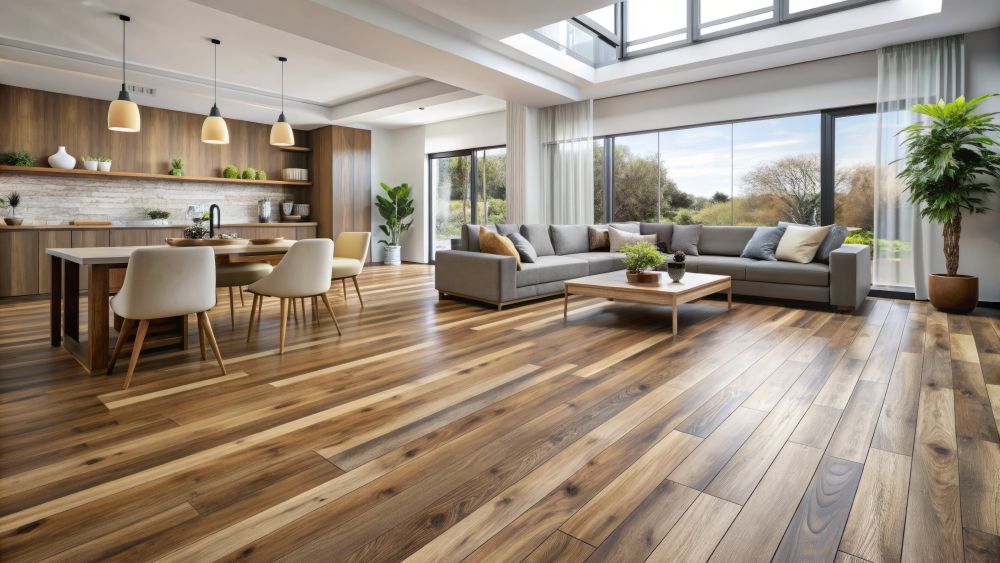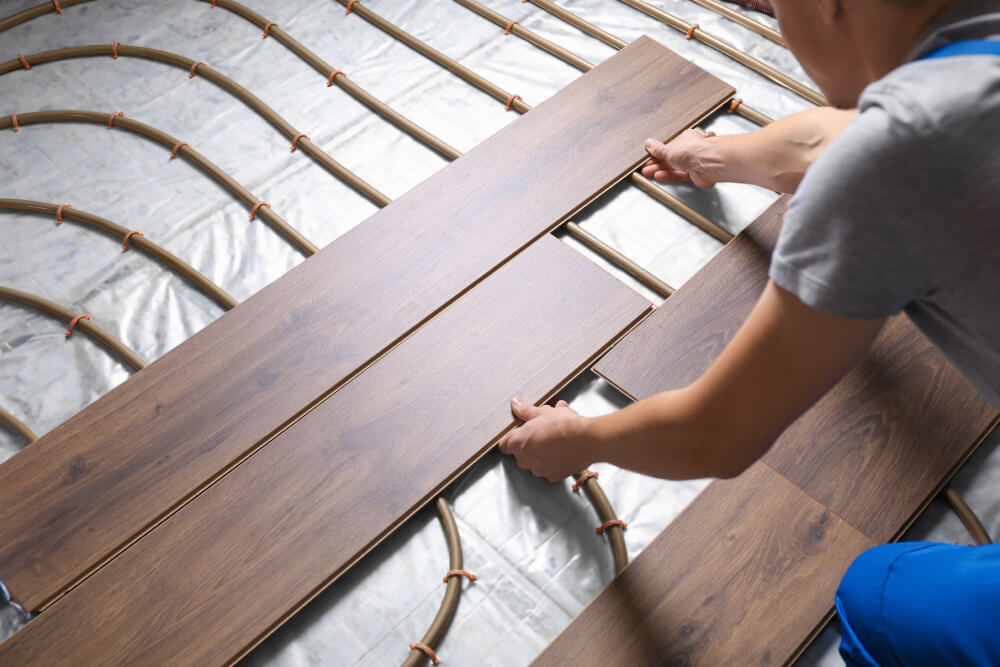1. Understanding Concrete Flooring
Overview: Concrete flooring is made from a mixture of cement, water, and aggregates such as sand, gravel, or crushed stone. When properly finished and sealed, concrete floors can offer a sleek and durable surface that complements a wide range of interior design styles. Concrete can be poured in place or used as pre-cast tiles, providing flexibility in installation and design.
Types of Concrete Flooring:
- Polished Concrete: Achieved by grinding the concrete surface with progressively finer diamond pads to achieve a smooth, glossy finish.
- Stained Concrete: Uses acid-based or water-based stains to add color and create various effects, such as marbling or mottling.
- Stamped Concrete: A technique that involves stamping patterns into the concrete surface to mimic the look of stone, tile, or wood.
- Sealed Concrete: A protective sealant is applied to the concrete surface to enhance its durability and resistance to stains and moisture.
2. Benefits of Concrete Flooring
- Durability and Longevity:
- High Strength: Concrete is an incredibly durable material that can withstand heavy foot traffic, making it ideal for high-traffic areas like kitchens, hallways, and living rooms.
- Long Lifespan: Properly installed and maintained concrete floors can last for decades without needing replacement.
- Versatility:
- Design Options: Concrete floors can be customized with various finishes, colors, and patterns to match any interior design style. Techniques like staining, polishing, and stamping offer endless possibilities.
- Compatibility: Concrete is compatible with radiant heating systems, providing an energy-efficient and comfortable flooring option for colder climates.
- Low Maintenance:
- Easy Cleaning: Concrete floors are easy to clean and maintain. Regular sweeping and occasional mopping with a mild cleaner are usually sufficient.
- Stain Resistance: When properly sealed, concrete is resistant to stains from spills and chemicals, making it a practical choice for kitchens and workshops.
- Eco-Friendly:
- Sustainable Material: Concrete is made from abundant natural materials, making it an eco-friendly choice. Additionally, using the existing concrete slab in your home can reduce the need for additional flooring materials.
- Energy Efficiency: Concrete floors have excellent thermal mass properties, helping to regulate indoor temperatures by absorbing and releasing heat. This can reduce the need for heating and cooling, leading to energy savings.
- Cost-Effective:
- Affordable Installation: The cost of installing concrete floors can be lower than other flooring options, especially if the existing concrete slab is used. Decorative finishes and treatments can increase the cost but still provide good value compared to premium flooring materials.
- Long-Term Savings: The durability and low maintenance requirements of concrete floors can lead to long-term savings on repairs and replacements.
Join HICP Homeowner’s Alliance
Connect with experts, get special discounts and enjoy member benefits
3. Drawbacks of Concrete Flooring
- Hardness:
- Unyielding Surface: Concrete floors are hard underfoot, which can be uncomfortable for long periods of standing or walking. This hardness can also lead to fatigue and discomfort.
- Impact on Objects: Dropped objects are more likely to break on a concrete floor compared to softer surfaces like carpet or vinyl.
- Coldness:
- Temperature Sensitivity: Concrete floors can be cold, especially in winter. While radiant heating systems can mitigate this issue, they add to the initial installation cost.
- Thermal Comfort: Without radiant heating, concrete may not provide the same level of thermal comfort as other flooring options.
- Susceptibility to Cracking:
- Cracks: Concrete can develop cracks over time due to settling, temperature changes, or improper installation. While some cracking is inevitable, it can be minimized with proper installation techniques and control joints.
- Aesthetic Impact: Visible cracks can detract from the appearance of the floor, although some homeowners appreciate the rustic, aged look they provide.
- Moisture Sensitivity:
- Moisture Issues: Concrete is porous and can absorb moisture if not properly sealed. This can lead to issues like mold and mildew in damp environments.
- Sealing Requirements: Regular resealing is necessary to maintain the floor’s resistance to moisture and stains.
- Installation Complexity:
- Professional Installation: While DIY installation is possible, achieving a high-quality finish typically requires professional expertise. The installation process can be labor-intensive and time-consuming.
4. Installation Tips for Concrete Flooring
- Preparation:
- Subfloor Assessment: Ensure the subfloor is clean, dry, and free of debris. Any existing flooring should be removed, and the surface should be level.
- Moisture Testing: Conduct moisture tests to determine if a vapor barrier or additional moisture mitigation is needed.
- Pouring Concrete:
- Mixing: Use a high-quality concrete mix and follow the manufacturer’s instructions for mixing and pouring.
- Reinforcement: Consider using reinforcing materials like wire mesh or rebar to enhance the strength and durability of the concrete.
- Pouring: Pour the concrete evenly, starting from one corner and working your way across the room. Use a screed to level the surface and remove excess concrete.
- Finishing Techniques:
- Troweling: Use a trowel to smooth and level the concrete surface. This step can be done manually or with a power trowel for larger areas.
- Texturing: Apply desired textures or patterns while the concrete is still wet. Stamping, broom finishing, or creating a polished surface are common techniques.
- Control Joints: Cut control joints into the concrete to prevent random cracking. These joints should be spaced appropriately based on the size and shape of the floor.
- Curing and Sealing:
- Curing: Allow the concrete to cure properly, which typically takes 28 days for full strength. Keep the surface moist during the curing process to prevent cracking.
- Sealing: Once the concrete is fully cured, apply a high-quality sealer to protect the surface from stains, moisture, and wear. Choose a sealer that suits the desired finish, whether glossy, matte, or satin.
- Polishing and Staining:
- Polishing: For polished concrete floors, use progressively finer diamond pads to grind and polish the surface to the desired level of shine.
- Staining: If staining the concrete, apply the stain according to the manufacturer’s instructions. Multiple coats may be needed to achieve the desired color and effect.
5. Maintaining Concrete Flooring
- Regular Cleaning:
- Sweeping: Sweep the floor regularly to remove dirt, dust, and debris. Use a soft-bristle broom to avoid scratching the surface.
- Mopping: Mop the floor with a mild, pH-neutral cleaner and water. Avoid using harsh chemicals or abrasive cleaners that can damage the sealant.
- Resealing:
- Frequency: Reseal the concrete floor every 2-3 years, or as needed, to maintain its protective layer and appearance.
- Application: Follow the manufacturer’s instructions for applying the sealer. Ensure the floor is clean and dry before sealing.
- Stain Removal:
- Immediate Action: Clean spills promptly to prevent staining. Blot the spill with a clean, absorbent cloth and avoid rubbing, which can spread the stain.
- Stain Treatments: Use a mild cleaner or a specially formulated concrete stain remover for tough stains. Test the cleaner on an inconspicuous area first.
- Preventative Measures:
- Furniture Pads: Use furniture pads or coasters to prevent scratches and dents from heavy furniture.
- Area Rugs: Place area rugs or mats in high-traffic areas and entryways to reduce wear and protect the surface.
- Avoid Harsh Chemicals: Avoid using harsh chemicals, such as ammonia or bleach, which can damage the sealant and the concrete surface.
Concrete flooring is a modern, durable, and versatile choice that offers numerous benefits for residential homes. Its strength, longevity, and wide range of finishes make it suitable for various interior design styles and applications. While concrete floors have some drawbacks, such as hardness, coldness, and susceptibility to cracking, these issues can be mitigated with proper installation and maintenance. By understanding the characteristics of concrete flooring, weighing the pros and cons, and following best practices for installation and care, homeowners can enjoy a stylish, practical, and long-lasting flooring solution that enhances the beauty and functionality of their living spaces. With its eco-friendly attributes and low maintenance requirements, concrete flooring is an excellent choice for those seeking a modern and sustainable flooring option for their home.








